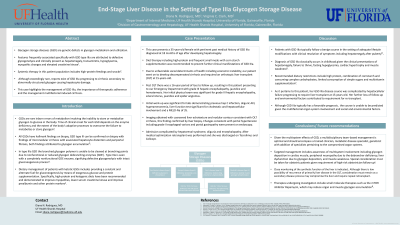Back


Poster Session A - Sunday Afternoon
Category: Liver
A0557 - End-Stage Liver Disease in the Setting of Type IIIa Glycogen Storage Disease
Sunday, October 23, 2022
5:00 PM – 7:00 PM ET
Location: Crown Ballroom

Has Audio

Diana N. Rodriguez, MD
UF Health Shands Hospital
Gainesville, Florida
Presenting Author(s)
Diana N. Rodriguez, MD
UF Health Shands Hospital, Gainesville, FL
Introduction: Glycogen storage diseases (GSD) are genetic defects in glycogen metabolism and utilization. Features of GSD 3 are attributed to defective glycogenolysis, including hepatomegaly, transaminitis, hypoglycemia, myopathic changes and elevated creatinine kinase. For confirmation, AGL gene mutation testing and measurement of debrancher enzyme activity are available. Symptomatic therapy includes high-protein feedings and high-protein snacks. Although rare, there are reports of GSD 3 progressing to cirrhosis due to abnormally structured glycogen damaging hepatocytes. We highlight the management of GSD 3 and the importance of therapeutic adherence for cirrhosis prevention.
Case Description/Methods: This is a 35-year-old female who presented with encephalopathy, jaundice, and hematemesis. She was diagnosed with GSD 3a at 18 months due to hepatomegaly. Diet therapy was recommended at this time, including high-protein and frequent small meals with corn starch supplementation. Diet therapy in GSD 3a is typically effective and has improved hypoglycemia, hepatomegaly, and overall development. Given dietary noncompliance including low protein and high carbohydrates, she developed cirrhosis and underwent OLT at 15-years-old. After a 16-year period of loss to follow up updated labs demonstrated a past Hepatitis C infection. Imaging demonstrated cirrhotic liver transplant, liver biopsy indeterminate for acute rejection and EGD with portal hypertension. Admission labs included hyperammonemia, hyperbilirubinemia, liver function with cholestatic and hepatocellular involvement, oliguric AKI and a MELD of 35. Physical exam was significant for hepatic encephalopathy grade III, jaundice and asterixis. Her admission was complicated by hepatorenal syndrome type I treated per protocol and oliguria managed with hemofiltration, encephalopathy complicated by failure to protect airway requiring intubation and severe malnutrition. Retransplant was performed and she was discharged on Tacrolimus and Cellcept.
Discussion: Patients with GSD 3a typically follow a benign course, symptoms resolving by early adulthood. In our case, hepatocellular failure predominated and progressed to require a liver transplant. This case highlights diet therapy being the primary treatment for GSD 3a. Whereas the course after liver transplant is typically benign, the importance of longitudinal outpatient follow-up post-liver transplant is imperative for monitoring chronic rejection and/or retransplant requirement.
Disclosures:
Diana N. Rodriguez, MD. A0557 - End-Stage Liver Disease in the Setting of Type IIIa Glycogen Storage Disease, ACG 2022 Annual Scientific Meeting Abstracts. Charlotte, NC: American College of Gastroenterology.
UF Health Shands Hospital, Gainesville, FL
Introduction: Glycogen storage diseases (GSD) are genetic defects in glycogen metabolism and utilization. Features of GSD 3 are attributed to defective glycogenolysis, including hepatomegaly, transaminitis, hypoglycemia, myopathic changes and elevated creatinine kinase. For confirmation, AGL gene mutation testing and measurement of debrancher enzyme activity are available. Symptomatic therapy includes high-protein feedings and high-protein snacks. Although rare, there are reports of GSD 3 progressing to cirrhosis due to abnormally structured glycogen damaging hepatocytes. We highlight the management of GSD 3 and the importance of therapeutic adherence for cirrhosis prevention.
Case Description/Methods: This is a 35-year-old female who presented with encephalopathy, jaundice, and hematemesis. She was diagnosed with GSD 3a at 18 months due to hepatomegaly. Diet therapy was recommended at this time, including high-protein and frequent small meals with corn starch supplementation. Diet therapy in GSD 3a is typically effective and has improved hypoglycemia, hepatomegaly, and overall development. Given dietary noncompliance including low protein and high carbohydrates, she developed cirrhosis and underwent OLT at 15-years-old. After a 16-year period of loss to follow up updated labs demonstrated a past Hepatitis C infection. Imaging demonstrated cirrhotic liver transplant, liver biopsy indeterminate for acute rejection and EGD with portal hypertension. Admission labs included hyperammonemia, hyperbilirubinemia, liver function with cholestatic and hepatocellular involvement, oliguric AKI and a MELD of 35. Physical exam was significant for hepatic encephalopathy grade III, jaundice and asterixis. Her admission was complicated by hepatorenal syndrome type I treated per protocol and oliguria managed with hemofiltration, encephalopathy complicated by failure to protect airway requiring intubation and severe malnutrition. Retransplant was performed and she was discharged on Tacrolimus and Cellcept.
Discussion: Patients with GSD 3a typically follow a benign course, symptoms resolving by early adulthood. In our case, hepatocellular failure predominated and progressed to require a liver transplant. This case highlights diet therapy being the primary treatment for GSD 3a. Whereas the course after liver transplant is typically benign, the importance of longitudinal outpatient follow-up post-liver transplant is imperative for monitoring chronic rejection and/or retransplant requirement.
Disclosures:
Diana Rodriguez indicated no relevant financial relationships.
Diana N. Rodriguez, MD. A0557 - End-Stage Liver Disease in the Setting of Type IIIa Glycogen Storage Disease, ACG 2022 Annual Scientific Meeting Abstracts. Charlotte, NC: American College of Gastroenterology.
